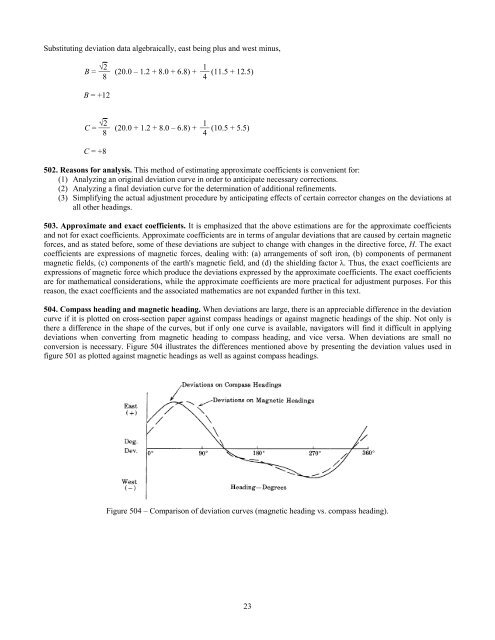Handbook of Magnetic Compass Adjustment - Maritime Safety ...
Handbook of Magnetic Compass Adjustment - Maritime Safety ...
Handbook of Magnetic Compass Adjustment - Maritime Safety ...
You also want an ePaper? Increase the reach of your titles
YUMPU automatically turns print PDFs into web optimized ePapers that Google loves.
Substituting deviation data algebraically, east being plus and west minus,<br />
√2 1<br />
B = 8<br />
(20.0 – 1.2 + 8.0 + 6.8) + 4<br />
(11.5 + 12.5)<br />
B = +12<br />
√2 1<br />
C = 8<br />
(20.0 + 1.2 + 8.0 – 6.8) + 4<br />
(10.5 + 5.5)<br />
C = +8<br />
502. Reasons for analysis. This method <strong>of</strong> estimating approximate coefficients is convenient for:<br />
(1) Analyzing an original deviation curve in order to anticipate necessary corrections.<br />
(2) Analyzing a final deviation curve for the determination <strong>of</strong> additional refinements.<br />
(3) Simplifying the actual adjustment procedure by anticipating effects <strong>of</strong> certain corrector changes on the deviations at<br />
all other headings.<br />
503. Approximate and exact coefficients. It is emphasized that the above estimations are for the approximate coefficients<br />
and not for exact coefficients. Approximate coefficients are in terms <strong>of</strong> angular deviations that are caused by certain magnetic<br />
forces, and as stated before, some <strong>of</strong> these deviations are subject to change with changes in the directive force, H. The exact<br />
coefficients are expressions <strong>of</strong> magnetic forces, dealing with: (a) arrangements <strong>of</strong> s<strong>of</strong>t iron, (b) components <strong>of</strong> permanent<br />
magnetic fields, (c) components <strong>of</strong> the earth's magnetic field, and (d) the shielding factor λ. Thus, the exact coefficients are<br />
expressions <strong>of</strong> magnetic force which produce the deviations expressed by the approximate coefficients. The exact coefficients<br />
are for mathematical considerations, while the approximate coefficients are more practical for adjustment purposes. For this<br />
reason, the exact coefficients and the associated mathematics are not expanded further in this text.<br />
504. <strong>Compass</strong> heading and magnetic heading. When deviations are large, there is an appreciable difference in the deviation<br />
curve if it is plotted on cross-section paper against compass headings or against magnetic headings <strong>of</strong> the ship. Not only is<br />
there a difference in the shape <strong>of</strong> the curves, but if only one curve is available, navigators will find it difficult in applying<br />
deviations when converting from magnetic heading to compass heading, and vice versa. When deviations are small no<br />
conversion is necessary. Figure 504 illustrates the differences mentioned above by presenting the deviation values used in<br />
figure 501 as plotted against magnetic headings as well as against compass headings.<br />
Figure 504 – Comparison <strong>of</strong> deviation curves (magnetic heading vs. compass heading).<br />
23

















